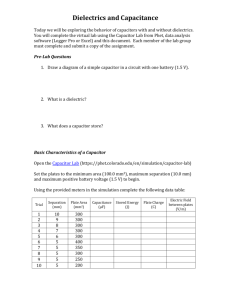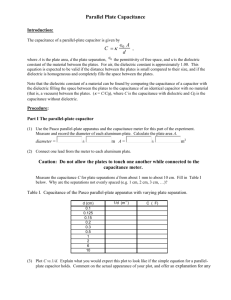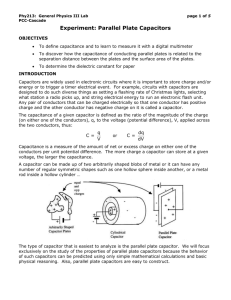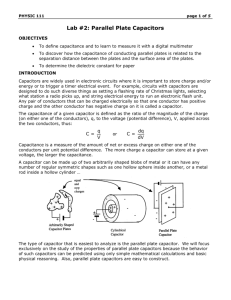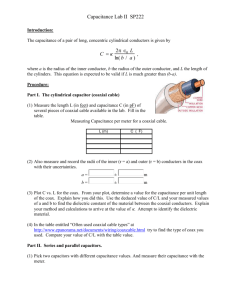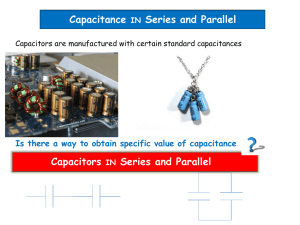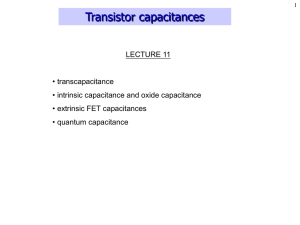LAB 3: Capacitors - Personal.psu.edu
advertisement
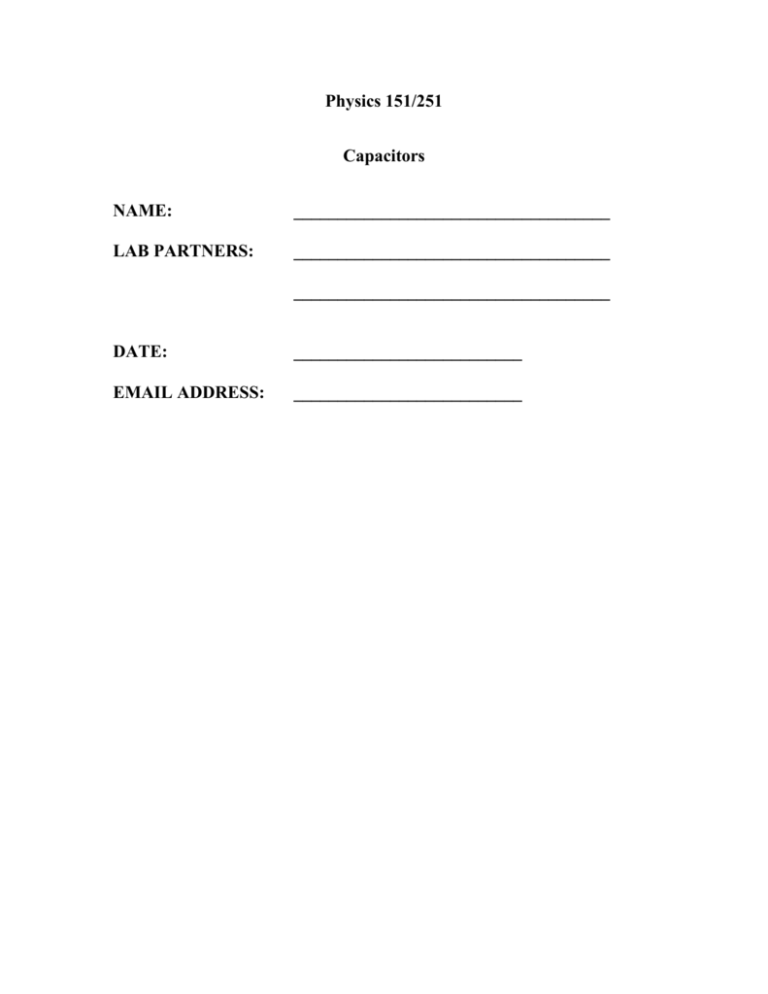
Physics 151/251 Capacitors NAME: ____________________________________ LAB PARTNERS: ____________________________________ ____________________________________ DATE: __________________________ EMAIL ADDRESS: __________________________ 1. Objectives. The objectives of this laboratory are a. to verify the dependence of capacitance on plate spacing for a parallel plate capacitor, and b. to measure the dielectric constant of paper. 2. Theory. (You should derive equation (1)) a. The capacitance of a parallel plate capacitor with no material between its plates is given by C0 = 0A/d (1) where C0 is the capacitance without any material between its plates, 0 is the permittivity of free space (8.8542 x 10-12 C2/(N m2), A is the surface area of a plate of the capacitor, and d is the separation distance between the plates. b. The capacitance of a parallel plate capacitor with a dielectric material filling the region between its plates is given by C = C0 = 0A/d (2) where is the dielectric constant for the material. c. In this experiment the plate area, A, is constant, while the plate separation distance, d, will be varied by inserting different thicknesses of dielectric material between the plates. From these measurements of A and d, the capacitance without dielectric present, C0, can be calculated from equation 1. The capacitance, C, for each thickness will be measured. To accomplish the objectives of the experiment, one graph will be constructed: A graph of capacitance, C, versus the reciprocal of the plate spacing, 1/d, should be a straight line. 3. Apparatus and experimental procedures. a. Equipment. 1) Aluminum Foil. 2) Physics Text Book. 3) Sticky Tape. 4) Multimeter/Alligator clips/leads. 5) Micrometer. 6) Ruler 7) Heavy Weights 4. Procedure. 1) Cut out two identical 10cm x 10cm square sheets of aluminum foil 2) Cut out two identical 2cm x 5cm rectangular sheets of aluminum foil. 3) Use the sticky tape to tape the 2x5 sheets (tabs) on the side of the 10x10 sheets (capacitor plates) such that the 2x5 sheets DO NOT OVERLAP at all when the combined sheets are place on top of each other. 4) Measure the thickness of 10 pages of your textbook when they are pushed together tightly using the micrometer. 5) Put the aluminum sheets inside the text book separated by 10 pages such that the square portions of the capacitor plates are exactly above each other and the tabs are coming out of the side of the book and are not overlapping at all and put a heavy weight on the text book. 6) Make a capacitance measurement. 7) Change the thickness of paper dielectric (i.e. the number of pages of the text book) and make another measurement ---- do this 10 times in all for different thicknesses. Record all data in tables below. 8) Note the capacitance reading when it should read zero. 5. Results 1) Plate dimensions. 2) Paper thickness measurements. 3) Capacitance measurements 3) A table with columns for number of sheets of paper, measured capacitance, and calculations for plate separation distance, reciprocal of plate separation distance, theoretical capacitance without dielectric present, and measured capacitance corrected for multimeter zero reading. Data 1. Plate dimensions. dimension measurement (m) length width 2. Paper thickness. item measurement number of sheets in stack thickness of stack m 3. Multimeter zero reading. F 4. Capacitance versus number of sheets of paper. # of sheets of paper capacitance (F) (uncorrected for zero) 8 12 16 20 24 28 32 36 40 44 6. Analysis . 1) Calculate plate area (excluding tabs). 2) Calculate thickness of a single sheet of paper. 3) Plot C for against 1/d using Excel and make the best linear fit. 4) From the resulting Excel plot read of the slope of the best linear fit. 5) Calculate the dielectric constant of the paper of the text book. 5. Conclusions. 1) A statement regarding the agreement or disagreement between the predicted and measured dependence of capacitance on plate separation distance for a parallel plate capacitor. 2) A statement about the zero reading of the multimeter and the intercept value of your graph.
